Road Freight Transport Electrification Potential by Using Battery Electric Trucks in Finland and Switzerland
Abstract
1. Introduction
- Many studies have conducted a comparative emission and/or cost analysis between a BET model and other alternative fuels and technology options based on average route characteristics [5,7,9,10,12,13,15]. However, only a few studies have conducted a parametric analysis for BET adoption to assess a large number of individual routes based on the origin–destination (O–D) road freight transport demand by different truck duty classes [14,22].
- Few studies have used a geospatial approach for analyzing the plug-in charging systems as well as ERSs in the large-scale BET adoption [14]. However, geospatial approaches have been widely used for modelling the plug-in charging infrastructures that is essential to analyzing the light passenger electric vehicles’ adoption rate [23,24,25,26,27].
- The power grid load requirements for charging facilities are rarely analyzed based on the geospatial distribution of road freight transport demand [30].
- using a random selection of BET models from a given pool in a simulation procedure. The random selection can be weighed for each BET model;
- using different search radii and charging trigger conditions for deviation from the pre-planned route assignments;
- covering large amount of route analysis for different countries based on a Google Maps application program interface (API). The route assignment is suitable for accurate addressing systems of O–D data based on the postal code zones (i.e., 5- and 4-digit postal codes in Finland and Switzerland);
- analyzing the multiple daily sub-trips, including multiple O–D pairs, as an individual trip in 24-h time frame. Accordingly, the charging and discharging (due to driving) activities will be simulated. As a result, the successful and failed trips (in the case that the BET has not arrived at the final destination and is out of charge) will be reported based on each daily trip data; and
- doing further geospatial analysis of the results based on the O–D data. Therefore, the results can be used for the geospatial resource allocation and infrastructure planning for depot and on-road charging facilities.
2. Data and Methods
2.1. Plug-In Charging Facilities Specifications
2.2. BET Model Specifications
2.3. Electric Road Scenario in Finland
2.4. Freight Transport Data Survey Preparation and Data Analytics Procedure
2.5. Extended Range Solutions
2.6. Annual Power Grid Load Requirements
3. Results
3.1. Scenario Package Result Analysis
3.1.1. Geospatial Accessibility Analysis of the Current on-Road Charging Facilities
3.1.2. BEVPO Model Simulation Results Plus the ERS Alternative Solution
3.2. Extended Range Solution
3.3. Power Grid Load Requirements for Different Electrification Scenarios
4. Discussion
5. Conclusions
Author Contributions
Funding
Data Availability Statement
Conflicts of Interest
Nomenclature
| API | Application Program Interface |
| BAU | Business-As-Usual |
| BET | Battery Electric Truck |
| BEV | Battery Electric Vehicle |
| BEVPO model | Battery Electric Vehicle Potential model |
| CT | Conventional Truck |
| EDV | Electric-Drive Vehicle |
| ERET | Extended Range Electric Truck |
| EREV | Extended-Range Electric Vehicle |
| ERS | Electric Road System |
| EU | European Union |
| FCEV | Fuel Cell Electric Vehicle |
| GHG emission | Greenhouse Gas emission |
| GVW | Gross Vehicle Weight |
| HDT | Heavy-Duty Truck |
| HEV | Hybrid Electric Vehicle |
| ICEV | Internal Combustion Engine Vehicle |
| kWh | Kilowatt hours |
| LCA | Life Cycle Assessment |
| MDT | Medium-Duty Truck |
| O–D | Origin-Destination |
| PHEV | Plug-in Hybrid Electric Vehicle |
| tkm | ton-kilometre |
| V2G | Vehicle-To-Grid |
| vRES | variable Renewable Energy Resource |
References
- Miller, J.D.; Façanha, C. The State of Clean Transport Policy: A 2014 Synthesis of Vehicle and Fuel Policy Developments; International Council on Clean Transportation (ICCT): Washington, DC, USA, 2014; p. 73. [Google Scholar]
- Moultak, M.; Lutsey, N.; Hall, D. White Paper: Transitioning to Zero-Emission Heavy-Duty Freight Vehicles; International Council on Clean Transportation (ICCT): Washington, DC, USA, 2017; p. 59. [Google Scholar]
- Muncrief, R.; Sharpe, B. Working Paper: Overview of the Heavy-Duty Vehicle Market and CO2 Emissions in the European Union; International Council on Clean Transportation (ICCT): Washington, DC, USA, 2015; pp. 1–59. [Google Scholar]
- Mulholland, E.; Teter, J.; Cazzola, P.; McDonald, Z.; Gallachóir, B.P. The long haul towards decarbonising road freight—A global assessment to 2050. Appl. Energy 2018, 216, 678–693. [Google Scholar] [CrossRef]
- Zhao, Y.; Tatari, O. Carbon and energy footprints of refuse collection trucks: A hybrid life cycle evaluation. Sustain. Prod. Consum. 2017, 12, 180–192. [Google Scholar] [CrossRef]
- Lee, D.Y.; Thomas, V.M. Parametric modeling approach for economic and environmental life cycle assessment of medium-duty truck electrification. J. Clean. Prod. 2017, 142, 3300–3321. [Google Scholar] [CrossRef]
- Lee, D.Y.; Thomas, V.M.; Brown, M.A. Electric urban delivery trucks: Energy use, greenhouse gas emissions, and cost-effectiveness. Environ. Sci. Technol. 2013, 47, 8022–8030. [Google Scholar] [CrossRef]
- Mareev, I.; Becker, J.; Sauer, D.U. Battery dimensioning and life cycle costs analysis for a heavy-duty truck considering the requirements of long-haul transportation. Energies 2018, 11, 55. [Google Scholar] [CrossRef]
- Zhao, Y.; Ercan, T.; Tatari, O. Life cycle based multi-criteria optimization for optimal allocation of commercial delivery truck fleet in the United States. Sustain. Prod. Consum. 2016, 8, 18–31. [Google Scholar] [CrossRef]
- Zhao, H.; Burke, A.; Zhu, L. Analysis of Class 8 hybrid-electric truck technologies using diesel, LNG, electricity, and hydrogen, as the fuel for various applications. In Proceedings of the 2013 World Electric Vehicle Symposium and Exhibition (EVS27), Barcelona, Spain, 17–20 November 2013; pp. 1–16. [Google Scholar]
- Palencia, J.C.; Nguyen, V.T.; Araki, M.; Shiga, S. The Role of Powertrain Electrification in Achieving Deep Decarbonization in Road Freight Transport. Energies 2020, 13, 2459. [Google Scholar] [CrossRef]
- Zhao, Y.; Onat, N.C.; Kucukvar, M.; Tatari, O. Carbon and energy footprints of electric delivery trucks: A hybrid multi-regional input-output life cycle assessment. Transp. Res. Part D Transp. Environ. 2016, 47, 195–207. [Google Scholar] [CrossRef]
- Sen, B.; Ercan, T.; Tatari, O. Does a battery-electric truck make a difference? Life cycle emissions, costs, and externality analysis of alternative fuel-powered Class 8 heavy-duty trucks in the United States. J. Clean. Prod. 2017, 141, 110–121. [Google Scholar] [CrossRef]
- Teoh, T.; Kunze, O.; Teo, C.C.; Wong, Y.D. Decarbonisation of urban freight transport using electric vehicles and opportunity charging. Sustainability 2018, 10, 3258. [Google Scholar] [CrossRef]
- Davis, B.A.; Figliozzi, M.A. A methodology to evaluate the competitiveness of electric delivery trucks. Transp. Res. Part E Logist. Transp. Rev. 2013, 49, 8–23. [Google Scholar] [CrossRef]
- Zhou, T.; Roorda, M.J.; MacLean, H.L.; Luk, J. Life cycle GHG emissions and lifetime costs of medium-duty diesel and battery electric trucks in Toronto, Canada. Transp. Res. Part D Transp. Environ. 2017, 55, 91–98. [Google Scholar] [CrossRef]
- Vora, A.P.; Jin, X.; Hoshing, V.; Saha, T.; Shaver, G.; Varigonda, S.; Wasynczuk, O.; Tyner, W.E. Design-space exploration of series plug-in hybrid electric vehicles for medium-duty truck applications in a total cost-of-ownership framework. Appl. Energy 2017, 202, 662–672. [Google Scholar] [CrossRef]
- Keller, V.; English, J.; Fernandez, J.; Wade, C.; Fowler, M.; Scholtysik, S.; Palmer-Wilson, K.; Donald, J.; Robertson, B.; Wild, P.; et al. Electrification of road transportation with utility controlled charging: A case study for British Columbia with a 93% renewable electricity target. Appl. Energy 2019, 253, 113536. [Google Scholar] [CrossRef]
- Taljegard, M.; Göransson, L.; Odenberger, M.; Johnsson, F. Impacts of electric vehicles on the electricity generation portfolio—A Scandinavian-German case study. Appl. Energy 2019, 235, 1637–1650. [Google Scholar] [CrossRef]
- Lap, T.; Benders, R.; van der Hilst, F.; Faaij, A. How does the interplay between resource availability, intersectoral competition and reliability affect a low-carbon power generation mix in Brazil for 2050? Energy 2020, 195, 116948. [Google Scholar] [CrossRef]
- Park, C. A Study of Smart Grid Effects on Electric Vehicle Management Considering the Change of the Power Capacity Mix. Open Transp. J. 2018, 12, 215–229. [Google Scholar] [CrossRef]
- Liimatainen, H.; van Vliet, O.; Aplyn, D. The potential of electric trucks—An international commodity-level analysis. Appl. Energy 2019, 236, 804–814. [Google Scholar] [CrossRef]
- Melliger, M.A.; Van Vliet, O.; Liimatainen, H. Anxiety vs reality–Sufficiency of battery electric vehicle range in Switzerland and Finland. Transp. Res. Part D Transp. Environ. 2018, 65, 101–115. [Google Scholar] [CrossRef]
- Bräunl, T.; Harries, D.; McHenry, M.; Wager, G. Determining the optimal electric vehicle DC-charging infrastructure for Western Australia. Transp. Res. Part D Transp. Environ. 2020, 84, 102250. [Google Scholar] [CrossRef]
- Guo, F.; Yang, J.; Lu, J. The battery charging station location problem: Impact of users’ range anxiety and distance convenience. Transp. Res. Part E Logist. Transp. Rev. 2018, 114, 1–8. [Google Scholar] [CrossRef]
- Hilton, G.; Kiaee, M.; Bryden, T.; Dimitrov, B.; Cruden, A.; Mortimer, A. A stochastic method for prediction of the power demand at high rate EV chargers. IEEE Trans. Transp. Electrif. 2018, 4, 744–756. [Google Scholar] [CrossRef]
- Wang, Y.; Bi, J. Optimal charging guidance strategies for electric vehicles by considering dynamic charging requests in a time-varying road network. arXiv 2019, arXiv:1908.03670. [Google Scholar]
- Colzi, F.; de Nigris, M.; Corti, A.; Savaresi, S.M. Extended range electric vehicles components preliminary sizing based on real mission profiles. In Proceedings of the 2013 World Electric Vehicle Symposium and Exhibition (EVS27), Barcelona, Spain, 17–20 November 2013; pp. 1–8. [Google Scholar]
- Redelbach, M.; Özdemir, E.D.; Friedrich, H.E. Optimizing battery sizes of plug-in hybrid and extended range electric vehicles for different user types. Energy Policy 2014, 73, 158–168. [Google Scholar] [CrossRef]
- Paffumi, E.; De Gennaro, M.; Martini, G. Innovative technologies for smart cities: Towards customer driven infrastructure design for large scale deployment of electric vehicles and Vehicle-to-Grid applications. Transp. Res. Procedia 2016, 14, 4505–4514. [Google Scholar] [CrossRef]
- BEVPO Model. Available online: https://github.com/MMWeb87/BEVPO/ (accessed on 30 September 2020).
- Openchargemap. Open Charge Map. 2020. Available online: https://openchargemap.org/site (accessed on 1 February 2020).
- Home.selasky. Downloadable Map Files for Electric Vehicle, EV, Charging Stations in Norway, Sweden and Finland. 2020. Available online: http://home.selasky.org/charging/ (accessed on 4 April 2020).
- Huismans, H. Electric Trucks: Wishful Thinking or the Real Deal. Master’s Thesis, Delft University of Technology, Delft, The Netherlands, 2018; p. 119. [Google Scholar]
- Energy. Sought Coast AQMD Presentation for Zero Emission Heavy Duty Drayage Truck Demonstration (MX30 Class 8). Available online: https://www.energy.gov/sites/prod/files/2014/03/f13/vss115_choe_2013_o.pdf (accessed on 30 September 2020).
- Commercialmotor, EMOSS Electric Trucks: Road Test. Available online: https://www.commercialmotor.com/news/buying-advice/emoss-electric-trucks-road-test (accessed on 30 September 2020).
- EMOSS. BET and Range Extender Models. Available online: http://www.emoss.nl/wp-content/uploads/brochure_emoss_2016_web.pdf (accessed on 19 February 2020).
- Electricvehicles. Electric Truck Manufacturers-Emoss Electric Trucks. Available online: https://electricvehicles.in/electric-truck-manufacturers-emoss-electric-trucks/ (accessed on 30 September 2020).
- DAF. Available online: https://www.daf.com/en/about-daf/sustainability/alternative-fuels-and-drivelines/battery-electric-vehicles/news-article-folder-bev/daf-cf-electric-drives-150000-electric-kilometres (accessed on 30 September 2020).
- BYD. Available online: https://en.byd.com/truck/#models (accessed on 30 September 2020).
- Langhelle, O.; Bohne, R.; Nørbech, T.E. Electric Roads in Norway: A Summary of a Concept Analysis. Electric Infrastructure for Good Transport (ELinGO), PDF Report, 2018, 30p. Available online: https://www.vegvesen.no/_attachment/2322599/binary/1262403?fast_title=Final+report+-+Electric+roads+in+Norway+-+Summary+of+a+concept+analysis.pdf (accessed on 30 September 2020).
- WSP Oy. Business Transportation on the Road Network Volume and Value Analysis in 2015, Online PDF Report, 2017, 52p. Available online: https://ek.fi/wp-content/uploads/Elinkeinoelaman-kuljetukset-tieverkolla_volyymi-ja-arvoanalyysi_WSP-Finland.pdf (accessed on 30 September 2020).
- BFS. BFS Goods Transport. 2018. Available online: https://www.bfs.admin.ch/bfs/en/home/statistics/mobility-transport/goods-transport.html (accessed on 4 April 2019).
- Statistics Finland 2018. Goods Transport by Road. 2018. Available online: http://stat.fi/til/kttav/index_en.html (accessed on 1 April 2019).
- Opendata Swiss. Official Index of Cities and Towns Including Postal Codes and Perimeter. 2018. Available online: https://opendata.swiss/en/dataset/amtliches-ortschaftenverzeichnis-mit-postleitzahl-und-perimeter (accessed on 30 September 2020).
- Statistics Finland 2015. Postal Code—Municipality Key in Finland. 2015. Available online: http://www.stat.fi/org/avoindata/paikkatietoaineistot/paavo_en.html (accessed on 20 February 2020).
- Process Model. O-D and Desire Lines Analysis for Road Freight Transport Finland vs. Switzerland. Available online: https://github.com/MehdiJahangirSamet/O-D-and-Desire-lines-for-road-freight-transport-Finland-vs.Switzerland (accessed on 30 September 2020).
- NST2007. Standard Goods Classification for Transport Statistics (NST). Available online: https://ec.europa.eu/eurostat/statistics-explained/index.php/Glossary:Standard_goods_classification_for_transport_statistics_(NST) (accessed on 30 September 2020).
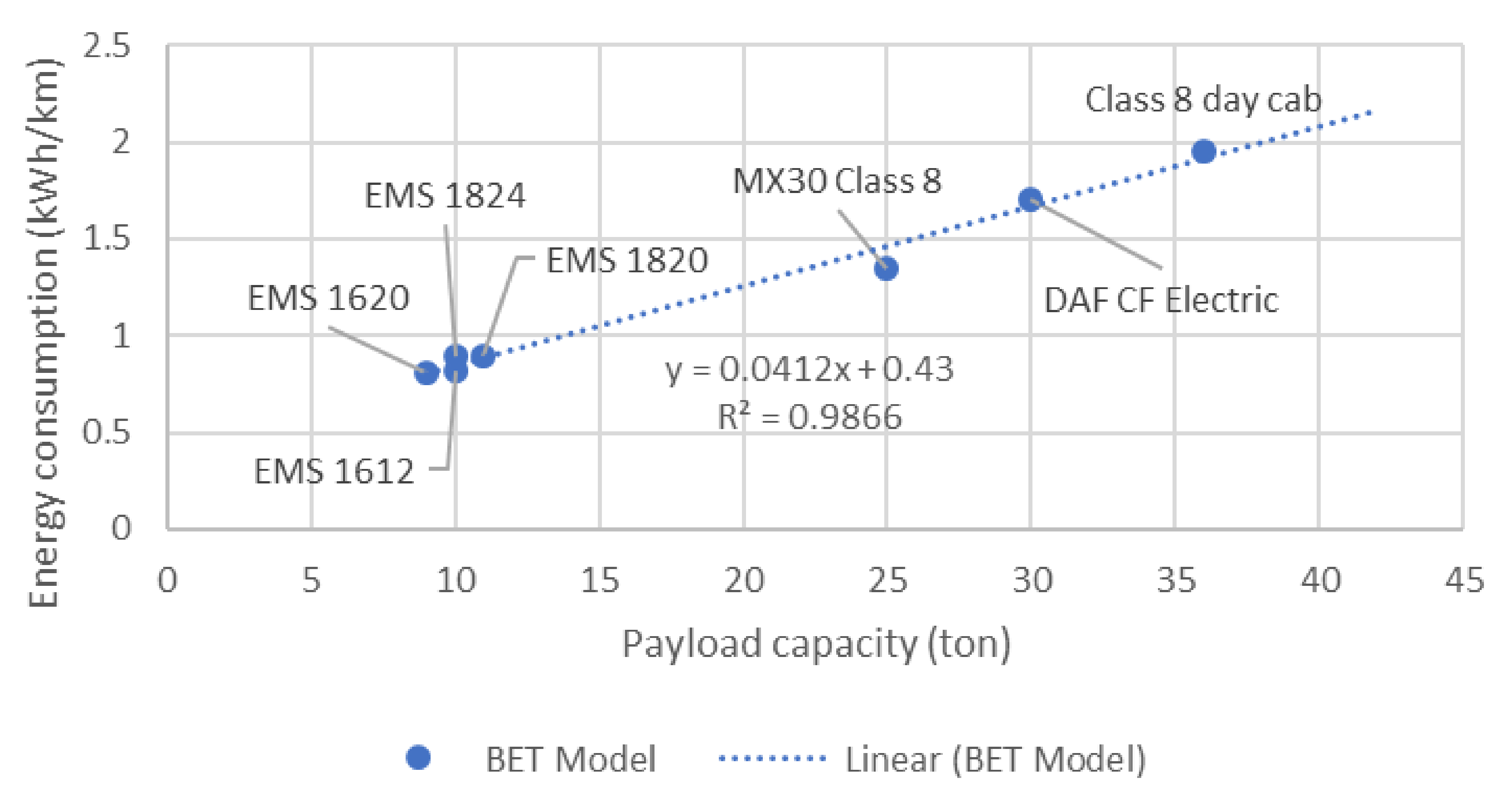


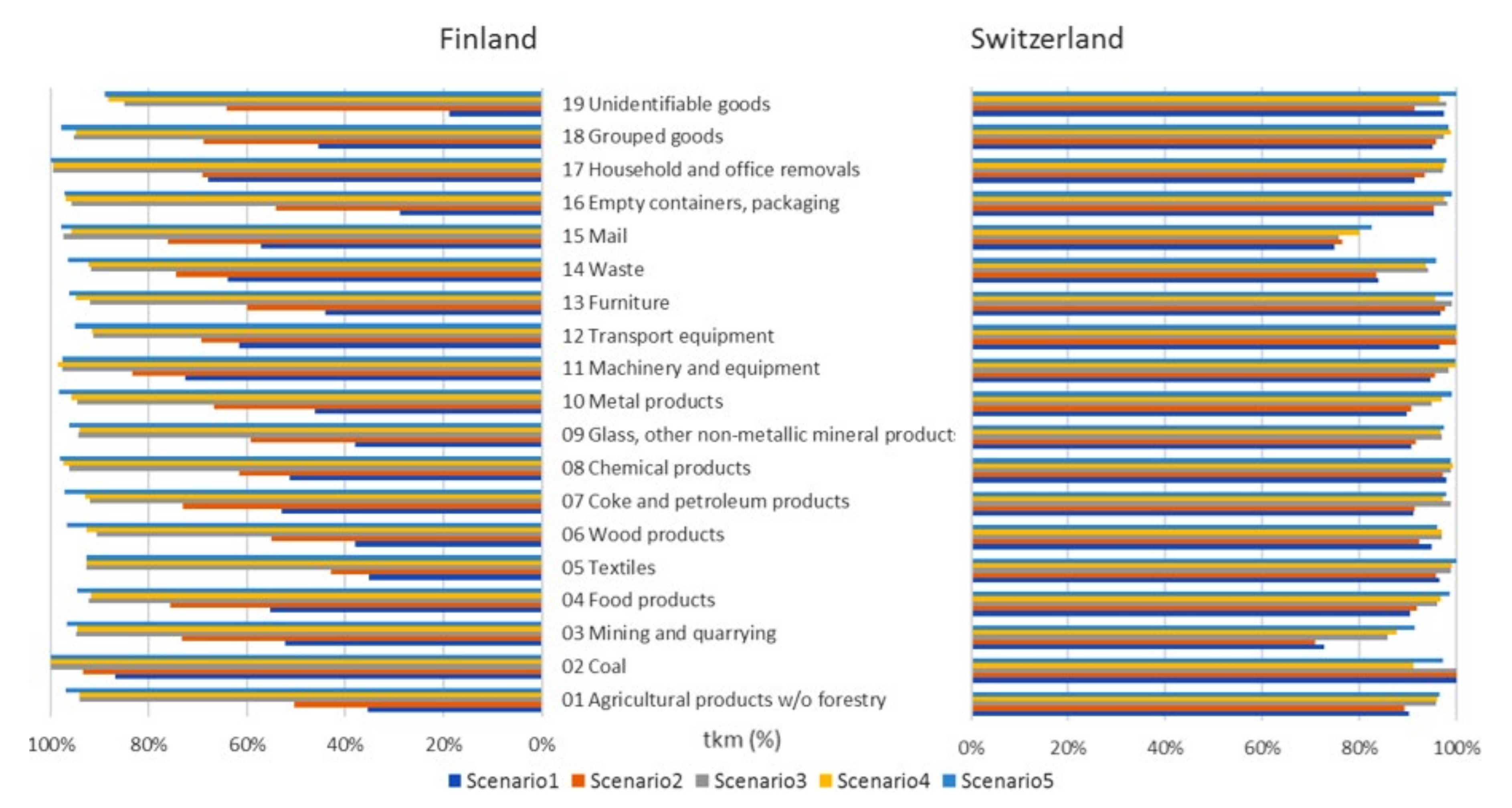
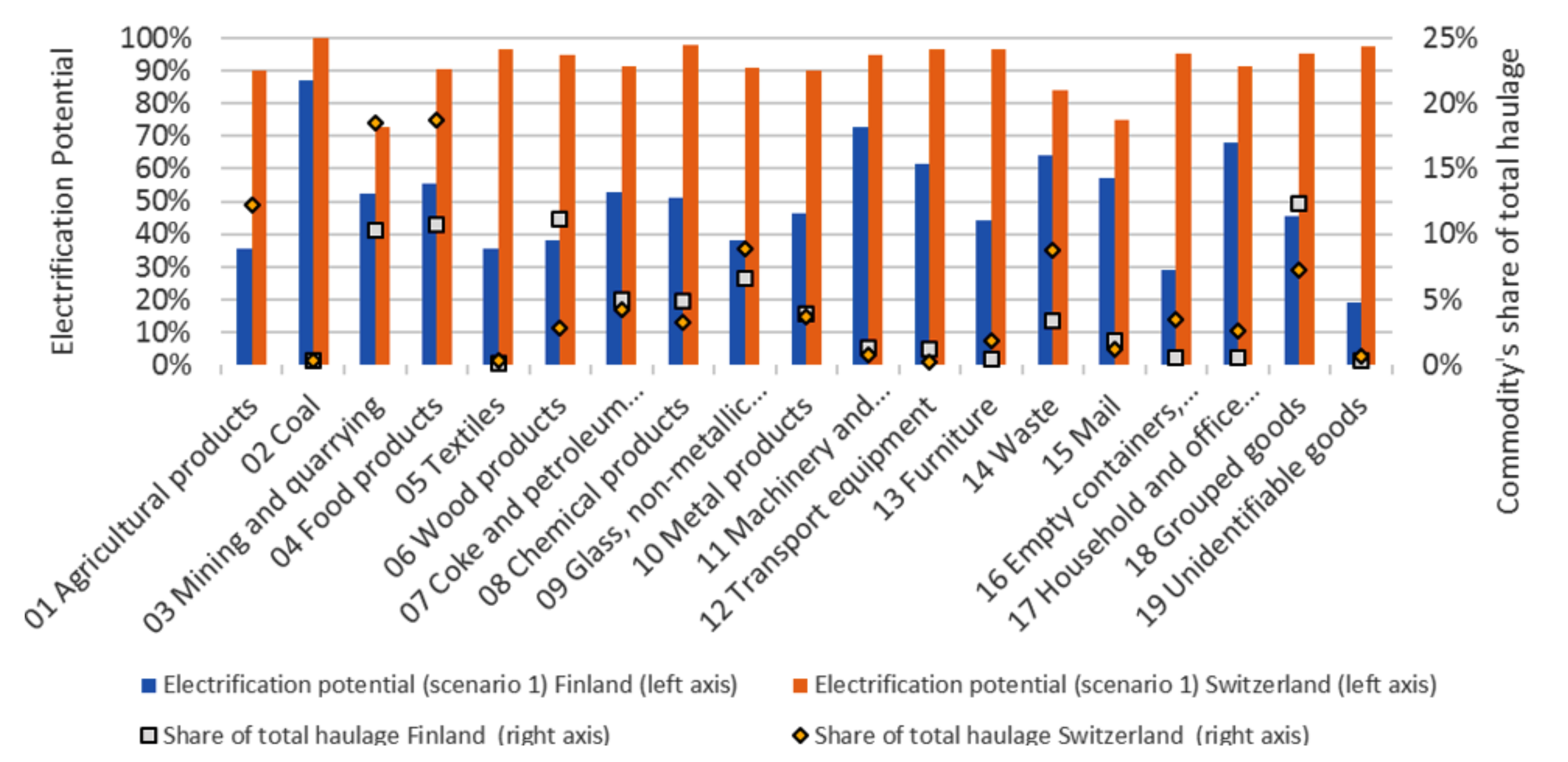

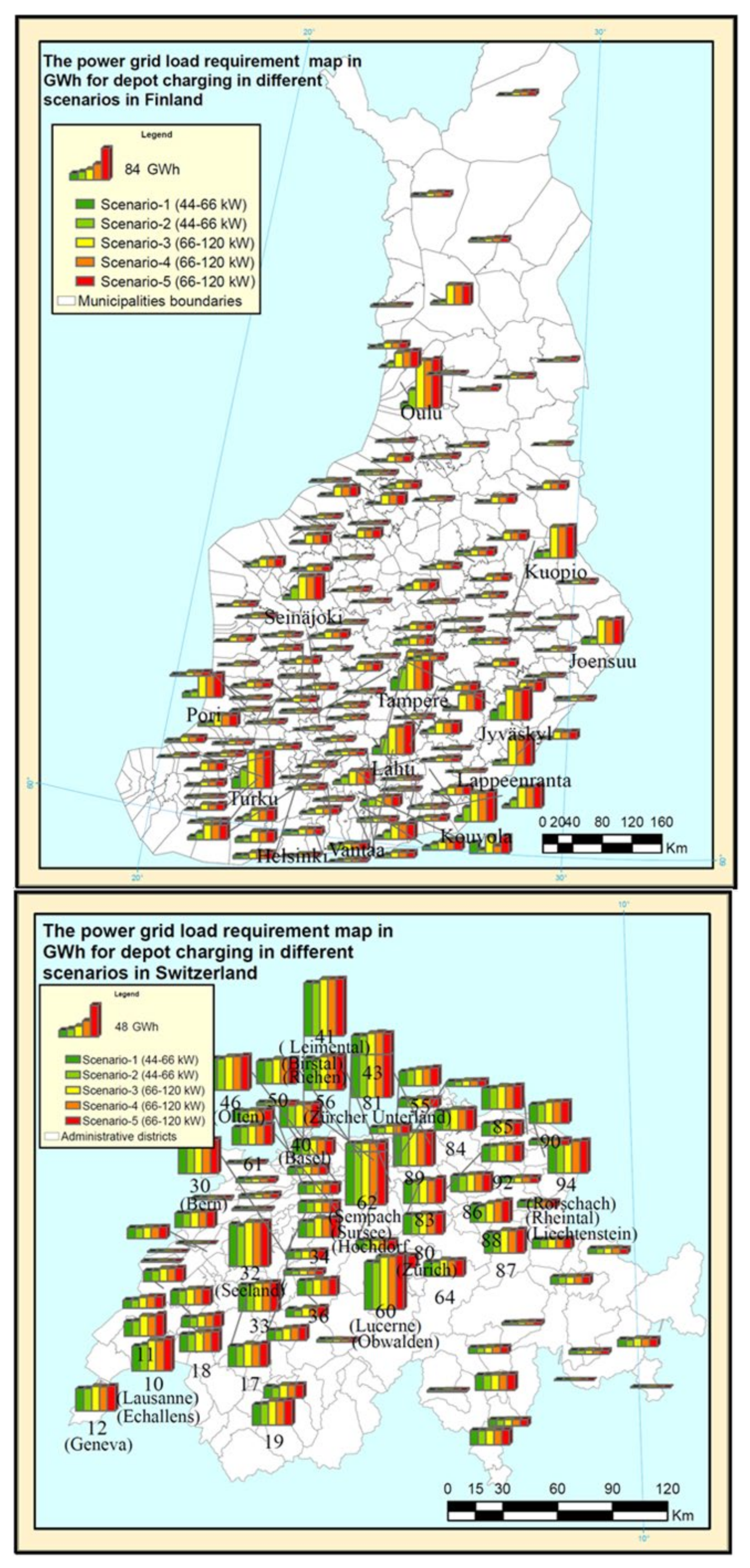
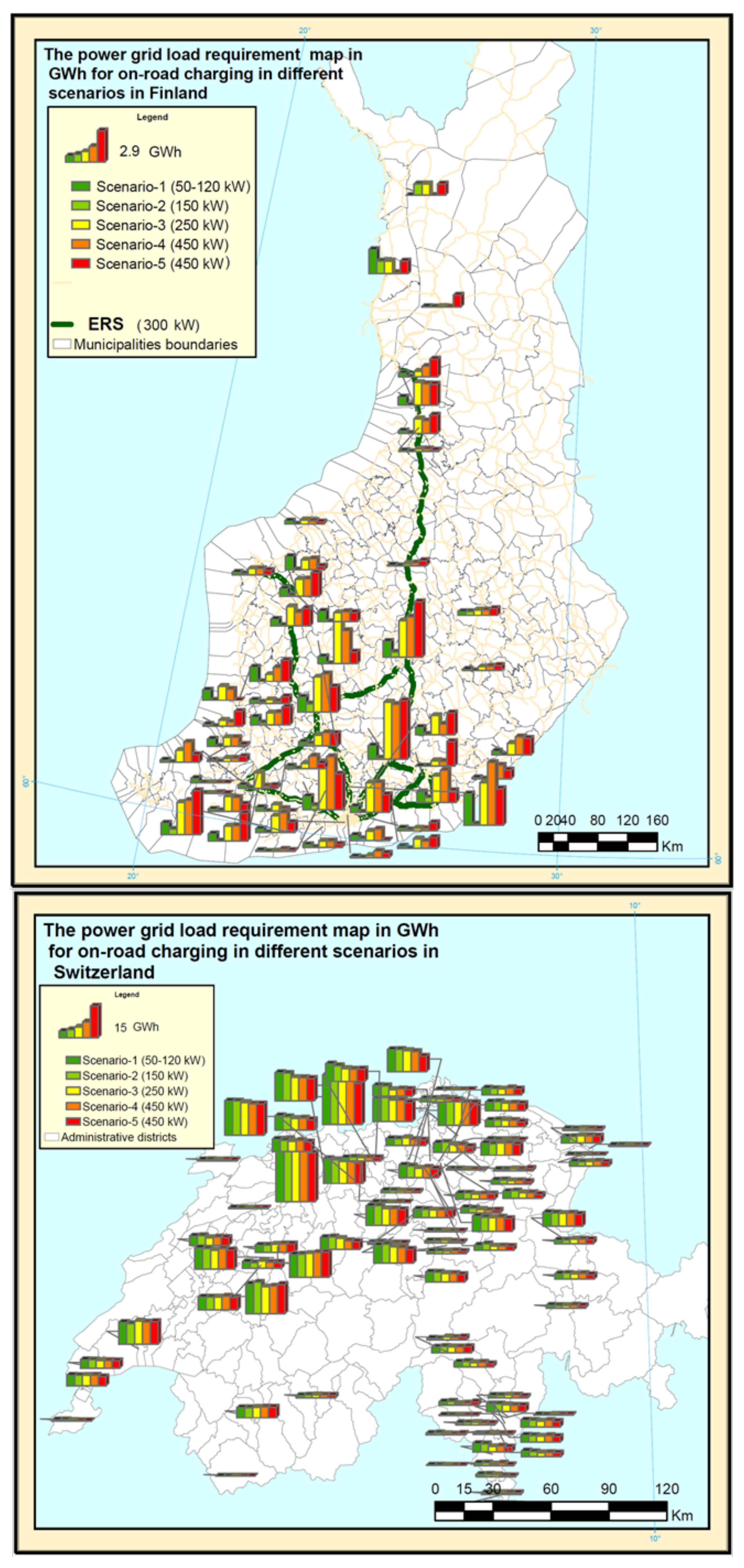
| Author(s) | Year | Region | EDV Technology | Truck Category | Origin–Destination (O–D) Data Analysis | Charging Activity Assessment | Geospatial Analysis | |||||
|---|---|---|---|---|---|---|---|---|---|---|---|---|
| Battery Electric Vehicle (BEV) | Extended-Range Electric Vehicle (EREV) | MDT | HDT | Plug-In Depot Charging | Plug-In On-Road Charging | Electric Road Systems (ERS) | Charging Activity | Power Grid Demand | ||||
| Lee et al. [7] | 2013 | US | √ | √ | ||||||||
| Zhao et al. [10] | 2013 | US | √ | √ | ||||||||
| Davis and Figliozzi [15] | 2013 | US | √ | √ | √ | √ | ||||||
| Zhao et al. [9] | 2016 | US | √ | √ | ||||||||
| Zhao et al. [12] | 2016 | US | √ | √ | √ | |||||||
| Zhao and Tatari [5] | 2017 | US | √ | √ | ||||||||
| Lee and Thomas [6] | 2017 | US | √ | √ | ||||||||
| Sen et al. [13] | 2017 | US | √ | √ | ||||||||
| Zhou et al. [16] | 2017 | Canada | √ | √ | ||||||||
| Vora et al. [17] | 2017 | US | √ | √ | ||||||||
| Mareev et al. [8] | 2018 | Germany | √ | √ | √ | |||||||
| Teoh et al. [14] | 2018 | Singapore | √ | √ | √ | √ | √ | √ | ||||
| Liimatainen et al. [12] | 2019 | Finland, Switzerland | √ | √ | √ | √ | √ | √ | ||||
| Palencia et al. [11] | 2020 | Japan | √ | √ | √ | |||||||
| This study | 2021 | Finland, Switzerland | √ | √ | √ | √ | √ | √ | √ | √ | √ | √ |
| Scenario 1 | Scenario 2 | Scenario 3 | Scenario 4 | Scenario 5 | |
|---|---|---|---|---|---|
| Depot charging power range in kW | 44–66 | 44–66 | 66–120 | 66–120 | 66–120 |
| On-road charging power range in kW | 50–120 | 150 | 250 | 450 | 450 |
| Payload Capacity Groups | Different Scenarios Represented by BET Features * | ||||
|---|---|---|---|---|---|
| Scenario 1 | Scenario 2 | Scenario 3 | Scenario 4 | Scenario 5 | |
| Group 1 with 4 BET models (payload capacity up to 11 t) | EMS 1612: 10 t, 125 km, 120 kWh, 0.82 kWh/km | EMS 1612: 10 t, 125 km, 120 kWh, 0.82 kWh/km | EMS 1612 (+50%): 10 t, 188 km, 180 kWh, 0.82 kWh/km | EMS 1612 (+50%): 10 t, 188 km, 180 kWh, 0.82 kWh/km | EMS 1612 (+75%): 10 t, 219 km, 210 kWh, 0.82 kWh/km |
| EMS 1620: 9 t, 210 km, 200 kWh, 0.81 kWh/km | EMS 1620: 9 t, 210 km, 200 kWh, 0.81 kWh/km | EMS 1620 (+50%): 9 t, 315 km, 300 kWh, 0.81 kWh/km | EMS 1620 (+50%): 9 t, 315 km, 300 kWh, 0.81 kWh/km | EMS 1620 (+75%): 9 t, 368 km, 350 kWh, 0.81 kWh/km | |
| EMS 1820: 11 t, 190 km, 200 kWh, 0.89 kWh/km | EMS 1820: 11 t, 190 km, 200 kWh, 0.89 kWh/km | EMS 1820 (+50%): 11 t, 285 km, 300 kWh, 0.89 kWh/km | EMS 1820 (+50%): 11 t, 285 km, 300 kWh, 0.89 kWh/km | EMS 1820 (+75%): 11 t, 333 km, 350 kWh, 0.89 kWh/km | |
| EMS 1824: 10 t, 230 km, 240 kWh, 0.89 kWh/km | EMS 1824: 10 t, 230 km, 240 kWh, 0.89 kWh/km | EMS 1824 (+50%): 10 t, 345 km, 360 kWh, 0.89 kWh/km | EMS 1824 (+50%): 10 t, 345 km, 360 kWh, 0.89 kWh/km | EMS 1824 (+75%): 10 t, 403 km, 420 kWh, 0.89 kWh/km | |
| Group 2 with 3 BET models (payload capacity 11–30 t) | MX30 Class 8: 25 t, 201 km, 320 kWh, 1.35 kWh/km | MX30 Class 8: 25 t, 201 km, 320 kWh, 1.35 kWh/km | MX30 Class 8 (+50%): 25 t, 302 km, 480 kWh, 1.35 kWh/km | MX30 Class 8 (+50%): 25 t, 302 km, 480 kWh, 1.35 kWh/km | MX30 Class 8 (+75%): 25 t, 352 km, 560 kWh, 1.35 kWh/km |
| Class 8-day cab: 36 t, 200 km, 435 kWh, 1.85 kWh/km | Class 8-day cab: 36 t, 200 km, 435 kWh, 1.85 kWh/km | Class 8-day cab (+50%): 36 t, 300 km, 653 kWh, 1.85 kWh/km | Class 8-day cab (+50%): 36 t, 300 km, 653 kWh, 1.85 kWh/km | Class 8-day cab (+75%): 36 t, 350 km, 761 kWh, 1.85 kWh/km | |
| DAF CF Electric: 30 t, 100 km, 170 kWh, 1.45 kWh/km | DAF CF Electric: 30 t, 100 km, 170 kWh, 1.45 kWh/km | DAF CF Electric (+50%): 30 t, 150 km, 255 kWh, 1.45 kWh/km | DAF CF Electric (+50%): 30 t, 150 km, 255 kWh, 1.45 kWh/km | DAF CF Electric (+75%): 30 t, 175 km, 298 kWh, 1.45 kWh/km | |
| Group 3 with only one BET model (payload capacity more than 30 t) | Not Evaluated | New Group 3: 42 t, 130 km, 340 kWh, 2.16 kWh/km | New Group 3 (+50%): 42 t, 200 km, 510 kWh, 2.16 kWh/km | New Group 3 (+50%): 42 t, 200 km, 510 kWh, 2.16 kWh/km | New Group 3 (+163%): 42 t, 350 km, 893 kWh, 2.16 kWh/km |
| Route No. | Routes * | Length (km) ** |
|---|---|---|
| 1 | Helsinki/Porvoo/Kotka/Hammina/Kouvola/Lahti | 305 |
| 2 | Helsinki/Turku | 165 |
| 3 | Helsinki/Tampere/Seinäjoki/Vaasa | 618 |
| 4 | Helsinki/Lahti/Jyväskylä/Oulu/Kemi | 825 |
| 5 | Turku/Tampere/Jyväskylä | 471 |
| Total | 2384 |
| Road Network Properties for Charging Facilities | Finland | Switzerland |
|---|---|---|
| Length of road network (km) * | 33,941 | 24,632 |
| Length of network covered by 50 km accessibility radius of charging stations (km) | 13,913 | 17,440 |
| Percentage of network covered by 50 km accessibility radius of charging stations | 41% | 71% |
| Public charging stations | 57 | 87 |
| Coverage area (overlaps included) km2 | 12,514 | 68,176 |
| Different Scenarios | On-Road Charging Ratio Range in % | ERS Charging Ratio Range in % | Finland | Switzerland | ||||||||
|---|---|---|---|---|---|---|---|---|---|---|---|---|
| Total Annual Electricity Needs | Total Charging Possibility Range by | Total Annual Electricity Needs | Total Charging Possibility Range by | |||||||||
| Total Electricity in GWh | % of Full Electrification * | Depot Charging in % | On-Road Charging in % | ERS in % | Total Electricity in GWh | % of Full Electrification * | Depot Charging in % | On-Road Charging in % | ERS in % | |||
| Scenario 1 | 0–100 | - | 739 | 20 | 100–86 | 0–14 | - | 2141 | 85 | 100–39 | 0–61 | - |
| Scenario 2 | 0–100 | 0–100 | 1833 | 48 | 100–38 | 0–1 | 0–61 | 2150 | 85 | 100–39 | 0–61 | - |
| Scenario 3 | 0–100 | - | 3300 | 87 | 100–93 | 0–7 | - | 2316 | 92 | 100–49 | 0–51 | - |
| Scenario 4 | 0–100 | - | 3280 | 87 | 100–93 | 0–7 | - | 2323 | 92 | 100–49 | 0–51 | - |
| Scenario 5 | 0–100 | - | 3457 | 91 | 100–93 | 0–7 | - | 2350 | 93 | 100–49 | 0–51 | - |
| Different Scenarios | Finland | Switzerland | ||||||||
|---|---|---|---|---|---|---|---|---|---|---|
| Total Annual Electricity Needs | Total Charging Possibility by | Total Annual Electricity Needs | Total Charging Possibility by | |||||||
| Total Electricity in GWh | % of Full Electrification | Depot Charging in % | On-Road Charging in % | ERS in % | Total Electricity in GWh | % of Full Electrification | Depot Charging in % | On-Road Charging in % | ERS in % | |
| Scenario 1 | 739 | 20 | 96 | 4 | - | 2141 | 85 | 82 | 18 | - |
| Scenario 2 | 1833 | 48 | 69 | 0 | 31 | 2150 | 85 | 82 | 18 | - |
| Scenario 3 | 3300 | 87 | 98 | 2 | - | 2316 | 92 | 85 | 15 | - |
| Scenario 4 | 3280 | 87 | 98 | 2 | - | 2323 | 92 | 85 | 15 | - |
| Scenario 5 | 3457 | 91 | 98 | 2 | - | 2350 | 93 | 86 | 14 | - |
Publisher’s Note: MDPI stays neutral with regard to jurisdictional claims in published maps and institutional affiliations. |
© 2021 by the authors. Licensee MDPI, Basel, Switzerland. This article is an open access article distributed under the terms and conditions of the Creative Commons Attribution (CC BY) license (http://creativecommons.org/licenses/by/4.0/).
Share and Cite
Jahangir Samet, M.; Liimatainen, H.; van Vliet, O.P.R.; Pöllänen, M. Road Freight Transport Electrification Potential by Using Battery Electric Trucks in Finland and Switzerland. Energies 2021, 14, 823. https://doi.org/10.3390/en14040823
Jahangir Samet M, Liimatainen H, van Vliet OPR, Pöllänen M. Road Freight Transport Electrification Potential by Using Battery Electric Trucks in Finland and Switzerland. Energies. 2021; 14(4):823. https://doi.org/10.3390/en14040823
Chicago/Turabian StyleJahangir Samet, Mehdi, Heikki Liimatainen, Oscar Patrick René van Vliet, and Markus Pöllänen. 2021. "Road Freight Transport Electrification Potential by Using Battery Electric Trucks in Finland and Switzerland" Energies 14, no. 4: 823. https://doi.org/10.3390/en14040823
APA StyleJahangir Samet, M., Liimatainen, H., van Vliet, O. P. R., & Pöllänen, M. (2021). Road Freight Transport Electrification Potential by Using Battery Electric Trucks in Finland and Switzerland. Energies, 14(4), 823. https://doi.org/10.3390/en14040823







